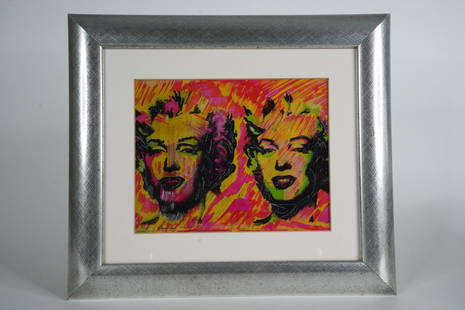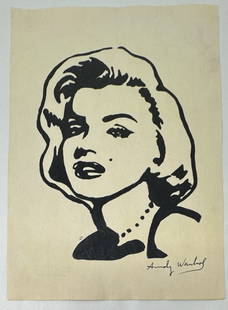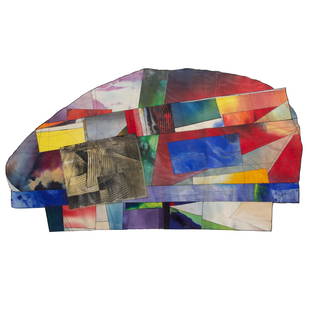
Andy Warhol (After). Marilyn.
Similar Sale History
View More Items in Mixed Media & CollagesRelated Mixed Media & Collages
More Items in Mixed Media & Collages
View MoreRecommended Art
View More









Item Details
Description
Andy Warhol (After).
(1928-1987, Pennsylvania and New York)
Marilyn.
1970. Stamped 'Published by Sunday B. Morning' and 'fill in your own signature' in black ink verso.
Stamp numbered 14/250 in black ink verso.
Screenprint in colors, on wove paper.
Full sheet printed to the edges, 36"x 36".
Archival frame is 37"x 37".
Based on a publicity photograph by Gene Kornman for the 1953 film Niagara.
Excellent condition with bright colors and desirable low print number.
Provenance: Ex Private European Collection.
The Mike Dale Collection.
Est. $5,000-$8,000.
Ship: $250
Literature:
For a description of the Andy Warhol Sunday B. Morning Marilyn prints, see: Freyda Feldman and Jorg Schellmann, Andy Warhol Prints: A Catalogue Raisonne 1962-1987, Fourth Edition Revised and Expanded by Freyda Feldman and Claudia Defendi, Distributed Art Publishers, Inc. in association with Ronald Feldman Fine Art, Inc., 2015, page 213.
Andy Warhol was born Andrew Warhola, Jr. in Pittsburgh, PA, on August 6, 1928, the fourth child of European immigrant parents from Austria-Hungary (now Slovakia). His father worked in a coal mine and died in an accident when Warhol was 13. After high school, Warhol enrolled in the Carnegie Institute of Technology, now Carnegie Mellon University in Pittsburgh, where he studied commercial art. After graduation, he moved to New York City and began a career in magazine illustration and advertising art. His first commission was to draw shoes for Glamour magazine in the late 1940s. In the 1950s, Warhol worked as a designer for shoe manufacturer Israel Miller.
After exhibiting his work in several galleries and museums in the late 1950s, including a group exhibition at the Museum of Modern Art in 1956, Warhol began to receive recognition as an influential and controversial artist. Warhol is best known as a legend in pop art—a movement that took off in the 1960s. His New York studio, The Factory, became a well-known gathering place that brought together distinguished intellectuals, drug addicts, drag queens, filmmakers, writers, Bohemian street people, Hollywood celebrities, and wealthy patrons. An openly gay man at a time when few had the courage to be so direct, Warhol fit perfectly into the eclectic cast of characters he surrounded himself with. His works explore the relationship between art, advertising, culture, and fame.
On June 3, 1968, Warhol survived an assassination attempt at The Factory. Radical feminist writer Valerie Solanas, a marginal figure in The Factory scene, shot Warhol and Mario Amaya, an art critic and curator. The latter received only minor injuries, but Warhol was seriously wounded and barely survived. Solanas turned herself in to police the next day, and was subsequently diagnosed with paranoid schizophrenia and sentenced to three years. After the shooting, security at The Factory increased dramatically. It was never the same.
In 1962, Warhol learned the silk screen printmaking process, a cheap and quick commercial printing technique that allowed him to mass-produce silkscreen versions of photographs and other imagery. Offered here are screenprints from the rare black ink unauthorized editions of 250 published by Sunday B. Morning in Belgium from the original negatives Warhol used to publish his "Factory Additions" screenprints of Marilyn and Flowers. In collaboration with Warhol, the Sunday B. Morning publishers decided that they would stamp on the back of their prints “fill in your own signature" as a play on the concept of mass production. There was a falling out between Warhol and the Sunday B. Morning publishers, possibly about money, and communication between them ceased.
The Belgian printers, already in possession of Warhol's negatives, went ahead and published editions of 250 of Marilyn, Flowers, and Campbell's Soup in 1970. When the Sunday B. Morning editions began appearing in the art market, Warhol was not pleased. He had not stopped the production of the unauthorized prints, but when he came across a Sunday B. Morning print he would sign it “This is not by me. Andy Warhol. " This only served to make the prints even more desirable. Today the black ink Sunday B. Morning prints from 1970 are hard to find with few having survived. Note the black ink stamps and print numbers. Both suggest the rarity of these pieces. Later editions are stamped using blue ink and are unnumbered.
During his long and illustrious career, Warhol was first and foremost an artist, expressing himself in a variety of media including drawing and painting, silkscreening, film, photography, and sculpture. Some of the subjects of his most famous works are connected to the world of entertainment, like Marilyn Monroe, Elvis Presley and Ingrid Bergman. Other famous works demonstrate his graphic arts and advertising background, like Campbell’s Soup Cans and Flowers. Warhol was not always appreciated by art critics. In 1979, reviewers disliked his exhibits of portraits of 1970s personalities and celebrities, calling them superficial and commercial and lacking in depth or any indication of the significance of the subjects. In hindsight, however, some critics have come to view Warhol's superficiality and commerciality as "the most brilliant mirror of our times," contending that "Warhol had captured something irresistible about the zeitgeist of American culture in the 1970s."
Warhol had a re-emergence of critical and financial success in the 1980s, partially due to his affiliation and friendships with a number of prolific younger artists like Jean-Michel Basquiat and Julian Schnabel. Before the 1984 Sarajevo Winter Olympics, he teamed with 15 other artists, including David Hockney and Cy Twombly, and contributed a Speed Skater print to the Art and Sport collection. The Speed Skater was used for the official Sarajevo Winter Olympics poster. Warhol died in his sleep on February 22, 1987, at age 58, from a sudden postoperative irregular heartbeat after gallbladder surgery.
On May 9, 2022, the Shot Sage Blue Marilyn (1964) painting by American art icon Andy Warhol sold at a Christie’s auction in New York for $195 million. This is not only the highest-ever price paid for the work of an American artist, it also sets the world record for the most expensive 20th-century work of art – a title previously held by Pablo Picasso’s Women of Algiers (1955), which sold at auction for $179.5 million in 2015. Warhol created Shot Sage Blue Marilyn in 1964—two years after Monroe’s sudden death—using a promotional photo from the 1953 film Niagara and gave the actress a pink face, blue eye shadow and red lips against a sage background. The work is one of Warhol’s coveted Shot Marilyns, a series of canvases featuring the star’s portrait in an array of colors, some of which were shot in the forehead with a single bullet by a visitor to Warhol’s New York studio, The Factory, according to legend.The Marilyn screenprint offered here was made from the same Niagara promotional photo as Shot Sage Blue Marilyn.
(1928-1987, Pennsylvania and New York)
Marilyn.
1970. Stamped 'Published by Sunday B. Morning' and 'fill in your own signature' in black ink verso.
Stamp numbered 14/250 in black ink verso.
Screenprint in colors, on wove paper.
Full sheet printed to the edges, 36"x 36".
Archival frame is 37"x 37".
Based on a publicity photograph by Gene Kornman for the 1953 film Niagara.
Excellent condition with bright colors and desirable low print number.
Provenance: Ex Private European Collection.
The Mike Dale Collection.
Est. $5,000-$8,000.
Ship: $250
Literature:
For a description of the Andy Warhol Sunday B. Morning Marilyn prints, see: Freyda Feldman and Jorg Schellmann, Andy Warhol Prints: A Catalogue Raisonne 1962-1987, Fourth Edition Revised and Expanded by Freyda Feldman and Claudia Defendi, Distributed Art Publishers, Inc. in association with Ronald Feldman Fine Art, Inc., 2015, page 213.
Andy Warhol was born Andrew Warhola, Jr. in Pittsburgh, PA, on August 6, 1928, the fourth child of European immigrant parents from Austria-Hungary (now Slovakia). His father worked in a coal mine and died in an accident when Warhol was 13. After high school, Warhol enrolled in the Carnegie Institute of Technology, now Carnegie Mellon University in Pittsburgh, where he studied commercial art. After graduation, he moved to New York City and began a career in magazine illustration and advertising art. His first commission was to draw shoes for Glamour magazine in the late 1940s. In the 1950s, Warhol worked as a designer for shoe manufacturer Israel Miller.
After exhibiting his work in several galleries and museums in the late 1950s, including a group exhibition at the Museum of Modern Art in 1956, Warhol began to receive recognition as an influential and controversial artist. Warhol is best known as a legend in pop art—a movement that took off in the 1960s. His New York studio, The Factory, became a well-known gathering place that brought together distinguished intellectuals, drug addicts, drag queens, filmmakers, writers, Bohemian street people, Hollywood celebrities, and wealthy patrons. An openly gay man at a time when few had the courage to be so direct, Warhol fit perfectly into the eclectic cast of characters he surrounded himself with. His works explore the relationship between art, advertising, culture, and fame.
On June 3, 1968, Warhol survived an assassination attempt at The Factory. Radical feminist writer Valerie Solanas, a marginal figure in The Factory scene, shot Warhol and Mario Amaya, an art critic and curator. The latter received only minor injuries, but Warhol was seriously wounded and barely survived. Solanas turned herself in to police the next day, and was subsequently diagnosed with paranoid schizophrenia and sentenced to three years. After the shooting, security at The Factory increased dramatically. It was never the same.
In 1962, Warhol learned the silk screen printmaking process, a cheap and quick commercial printing technique that allowed him to mass-produce silkscreen versions of photographs and other imagery. Offered here are screenprints from the rare black ink unauthorized editions of 250 published by Sunday B. Morning in Belgium from the original negatives Warhol used to publish his "Factory Additions" screenprints of Marilyn and Flowers. In collaboration with Warhol, the Sunday B. Morning publishers decided that they would stamp on the back of their prints “fill in your own signature" as a play on the concept of mass production. There was a falling out between Warhol and the Sunday B. Morning publishers, possibly about money, and communication between them ceased.
The Belgian printers, already in possession of Warhol's negatives, went ahead and published editions of 250 of Marilyn, Flowers, and Campbell's Soup in 1970. When the Sunday B. Morning editions began appearing in the art market, Warhol was not pleased. He had not stopped the production of the unauthorized prints, but when he came across a Sunday B. Morning print he would sign it “This is not by me. Andy Warhol. " This only served to make the prints even more desirable. Today the black ink Sunday B. Morning prints from 1970 are hard to find with few having survived. Note the black ink stamps and print numbers. Both suggest the rarity of these pieces. Later editions are stamped using blue ink and are unnumbered.
During his long and illustrious career, Warhol was first and foremost an artist, expressing himself in a variety of media including drawing and painting, silkscreening, film, photography, and sculpture. Some of the subjects of his most famous works are connected to the world of entertainment, like Marilyn Monroe, Elvis Presley and Ingrid Bergman. Other famous works demonstrate his graphic arts and advertising background, like Campbell’s Soup Cans and Flowers. Warhol was not always appreciated by art critics. In 1979, reviewers disliked his exhibits of portraits of 1970s personalities and celebrities, calling them superficial and commercial and lacking in depth or any indication of the significance of the subjects. In hindsight, however, some critics have come to view Warhol's superficiality and commerciality as "the most brilliant mirror of our times," contending that "Warhol had captured something irresistible about the zeitgeist of American culture in the 1970s."
Warhol had a re-emergence of critical and financial success in the 1980s, partially due to his affiliation and friendships with a number of prolific younger artists like Jean-Michel Basquiat and Julian Schnabel. Before the 1984 Sarajevo Winter Olympics, he teamed with 15 other artists, including David Hockney and Cy Twombly, and contributed a Speed Skater print to the Art and Sport collection. The Speed Skater was used for the official Sarajevo Winter Olympics poster. Warhol died in his sleep on February 22, 1987, at age 58, from a sudden postoperative irregular heartbeat after gallbladder surgery.
On May 9, 2022, the Shot Sage Blue Marilyn (1964) painting by American art icon Andy Warhol sold at a Christie’s auction in New York for $195 million. This is not only the highest-ever price paid for the work of an American artist, it also sets the world record for the most expensive 20th-century work of art – a title previously held by Pablo Picasso’s Women of Algiers (1955), which sold at auction for $179.5 million in 2015. Warhol created Shot Sage Blue Marilyn in 1964—two years after Monroe’s sudden death—using a promotional photo from the 1953 film Niagara and gave the actress a pink face, blue eye shadow and red lips against a sage background. The work is one of Warhol’s coveted Shot Marilyns, a series of canvases featuring the star’s portrait in an array of colors, some of which were shot in the forehead with a single bullet by a visitor to Warhol’s New York studio, The Factory, according to legend.The Marilyn screenprint offered here was made from the same Niagara promotional photo as Shot Sage Blue Marilyn.
Buyer's Premium
- 25%
Andy Warhol (After). Marilyn.
Estimate $5,000 - $8,000
43 bidders are watching this item.
Shipping & Pickup Options
Item located in Buford, GA, us$250 shipping in the US
Local Pickup Available
Payment
Accepts seamless payments through LiveAuctioneers

Related Searches
TOP





















































































